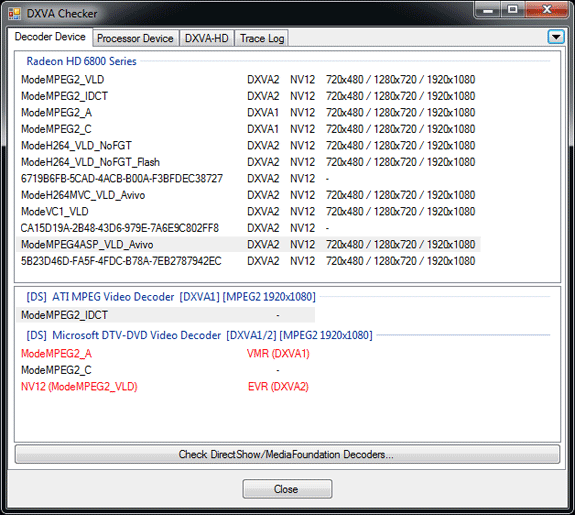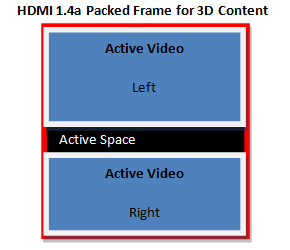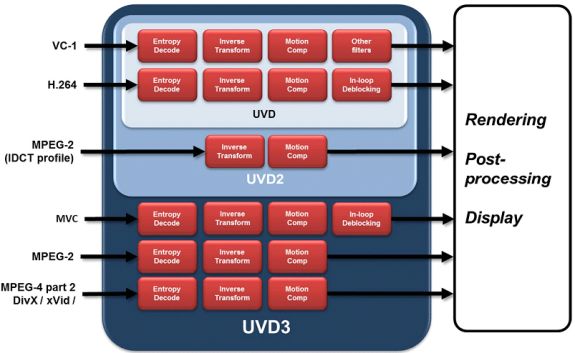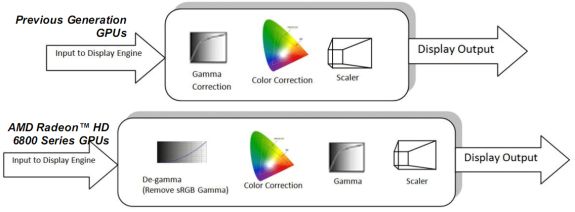AMD’s Radeon HD 6870 & 6850: Renewing Competition in the Mid-Range Market
by Ryan Smith on October 21, 2010 10:08 PM ESTSeeing the Present: HDMI 1.4a, UVD3, and Display Correction
DisplayPort wasn’t the only aspect of AMD’s display controller that got an overhaul however, AMD’s HDMI capabilities have also been brought up to modern standards. Coming from Cypress with support for HDMI 1.3, AMD now supports HDMI 1.4a on the Barts based 6800 series and presumably they will do so on the rest of the 6800 series too. With HDMI 1.4a support AMD can now support full resolution (1080p) 3D stereoscopy for movies, and 720p for games and other material that require 60Hz/eye, along with 4k x 2k resolution for monitors and TVs that have equivalent support. Unlike DP this has less to do with monitors and more to do with TVs, so the importance of this will be seen more on future AMD cards when AMD refreshes their lower-end parts that we normally use with HTPCs.
Launching alongside support for displaying full resolution 3D stereoscopic video is the hardware necessary to decode such video, in the form of the latest version of AMD’s Unified Video Decoder: UVD3. The last time UVD received a major update was with UVD2, which launched alongside the Radeon HD 4000 series and added partial MPEG-2 decoding support by moving IDCT and MoComp from shaders in to the UVD fixed function hardware.
With the Radeon 6800 series AMD is releasing UVD3, which like UVD2 before it builds on the existing UVD feature set. UVD3 is adding support for 3 more-or-less new codecs: MPEG-2, MVC, and MPEG-4 ASP (better known as DivX/XviD). Starting with MPEG-4 ASP, it’s the only new codec in supported by UVD3 that’s actually new, as previously all MPEG-4 ASP decoding was done in software when it came to AMD GPUs. With UVD3 AMD can now completely offload MPEG-4 ASP decoding to the GPU, bringing forth the usual advantages of greatly reducing the amount of work the CPU needs to do and ideally reducing power consumption in the process.
AMD adding MPEG-4 ASP support gives us an interesting chance to compare and contrast them to NVIDIA, who added similar support a year ago in the GT21x GPUs. AMD is a good bit behind NVIDIA here, but they’re making up for it by launching with much better software support for this feature than NVIDIA did; NVIDIA still does not expose their MPEG-4 ASP decoder in most situations, and overall did a poor job of advertising it. When we talked with DivX (who is AMD’s launch partner for this feature) they didn’t even know that NVIDIA had MPEG-4 ASP support. Meanwhile AMD is launching with DivX and had a beta version of the DivX codec with UVD3 support ready to test, and furthermore AMD is fully exposing their MPEG-4 ASP capabilities in their drivers as we see in this DXVA Checker screenshot.

The only downside at this time is that even with Microsoft’s greater focus on codecs for Windows 7, Windows 7 doesn’t know what to do with DXVA acceleration of MPEG-4 ASP. So while Win7 can play MPEG-4 ASP in software, you’re still going to need a 3rd party codec like the DivX codec to get hardware support for MPEG-4 ASP.
The other bit worth mentioning is that while AMD is launching support for MPEG-4 ASP decoding here on the 6800 series, much like HDMI 1.4a it’s not going to be a big deal for the 6800 series market. MPEG-4 ASP is a fairly lightweight codec, so support for it is going to be a bigger deal on low-end products, particularly AMD’s APUs if Llano and Bobcat end up using UVD3, as MPEG-4 ASP decoding in software requires a much greater share of resources on those products.
Up next is MPEG-2, which has been a codec stuck in limbo for quite some time over at AMD. MPEG-2 is even older and easier to decode than MPEG-4 ASP, and while GPUs have supported MPEG-2 decode acceleration as early as last decade, CPUs quickly became fast enough that when combined with low levels of hardware decode acceleration (inverse discrete cosine transform) was more than enough to play MPEG-2 content. Thus AMD hasn’t done much with MPEG-2 over the years other than moving IDCT/MoComp from the shaders to UVD for UVD2.
Because of the similarities between MPEG-4 ASP and MPEG-2, when AMD added support for full MPEG-4 ASP decode acceleration they were able to easily add support for full MPEG-2 decode acceleration, as they were able to reuse the MPEG-4 ASP entropy decode block for MPEG-2. As a result of including full MPEG-4 ASP decode acceleration, AMD now supports full MPEG-2 decode acceleration. Even more so than MPEG-4 ASP however, the benefits for this are going to lie with AMD’s low-end products where getting MPEG-2 off of the CPU should be a boon for battery life.

The final addition to UVD3 is support for Multiview Video Coding, which isn’t a new codec per se, but rather is an extension to H.264 for 3D stereoscopy. H.264 needed to be amended to support the packed frame formats used to store and transmit 3D stereoscopic videos, so with UVD3 AMD is adding support for MVC so that UVD can handle Blu-Ray 3D.
Finally, coupled with support for new codecs and new display outputs in AMD’s display controller is a refinement of AMD’s existing color correction capabilities in their display controller. Cypress and the rest of the 5000 series could do color correction directly on their display controllers, but they could only do so after gamma correction was applied, meaning they had to work in the non-linear gamma color space. Technically speaking this worked, but color accuracy suffered as a result. With the 6800 series’ new display controller, AMD can now perform color calibration in linear space by converting the image from gamma to linear color space for the color correction, before converting it back to gamma color space for display purposes.
As color correction is being used to correct for wide-gamut monitors the importance of this change won’t be seen right away for most users, but as wide-gamut monitors become more widespread color correction becomes increasingly important since wide-gamut monitors will misinterpret the normal sRGB colorspace that most rendering is done in.












197 Comments
View All Comments
Ryan Smith - Friday, October 22, 2010 - link
In case it isn't obvious from the slipshod organization of the article, we didn't quite get it done on time. We had less than a week to put this article together when normally for an article of this size it takes 2 weeks. Check back in the morning, everything on Eyefinity, DP1.2, etc will be up by then.counter03 - Friday, October 22, 2010 - link
i am quite interested in that 'mst hub'.is there any available product now?well,i just find nothing with google.wolrah - Friday, October 22, 2010 - link
The card still has two TMDS clock generators. This means only two DVI/HDMI displays can be driven off the card at one time, no matter what connection. With that in mind, I wouldn't be surprised if the card doesn't even support passive adapters as there is literally no good reason to ever use them. You already have two native ports, so with a maximum of two DVI displays that's that.Regardless of if passive adapters are supported, you'll still need active adapters or native DisplayPort on your display to run three or four monitors off this card.
Supposedly it also supports DisplayPort daisy chaining, so possibly when monitors arrive that have an out port it may handle more than four displays, but again only a maximum of two can be DVI/HDMI without active adapters.
ninjaquick - Monday, October 25, 2010 - link
DP support shouldn't be a problem since I've seen quite a few monitors coming out with DP in and some with I/O.Abot13 - Saturday, October 23, 2010 - link
With the 6800 series the cards can support up to 6 monitors in Eyefinity. The DP ports can use a DP hub or the monitors can be chained with DP. Either way the max is 6 monitors per card.ol1bit - Thursday, October 21, 2010 - link
The naming stinks, but I can see how these cards will be a big Christmas season for AMD.So people that don't the new naming scheme will rush out an buy the bigger names. Smooth Marketing Move.
Well, if the 6900's launch next month, that will be fun to see.
Zokudu - Thursday, October 21, 2010 - link
You removed Left 4 Dead from your benchmarks. Does this mean you won't be replacing it with another Source game (ie L4D2 or maybe Portal 2 when that releases)?I know its not 100% perfect but 3 of the top 10 selling games on steam right now are run on the Source engine and the only other ones that share and engine are BF:BC2 and MoH both using Frostbite. I would think that having some form of a Source game in there would be a good idea considering the vast amount of popular games that run on it. I always used the L4D benchmark to compare performance for TF2 and CS:S. in the past.
Otherwise good review and I'm excited for the HD6900 launch next month.
Ryan Smith - Friday, October 22, 2010 - link
By the time Portal 2 comes out, it'll be about the time we refresh our suite anyhow. For the time being the existing Source games run on anything (even the GT 430 got L4D playable at 1680 with 4xAA) so it's not a useful benchmark, especially since there's no guarantee Portal will run that well.AmdInside - Thursday, October 21, 2010 - link
In the 3DTV Play article, you mentioned AMD's 6000 series would challenge NVIDIA in 3D with the 6000 series but I didn't read any info on it in this article. What gives?StevoLincolnite - Friday, October 22, 2010 - link
Also didn't see any mention of the improved crossfire performance either...